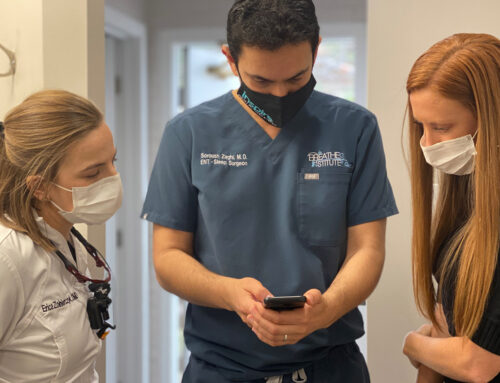As I pointed out in this page on my site, sleep apnea and sleep disordered breathing are getting far more attention than they ever have before. We’re starting to realize that sleep apnea and related issues are more widespread and more concerning than we originally thought.
Everyone from doctors, dentists and other health practitioners, to patients and mainstream media are becoming increasingly aware of these issues. This is translating into a focused, effective and insightful response from the healthcare community, and better outcomes for patients. That makes me very happy because I see so many patients with sleep apnea and its related signs and symptoms. It’s great to know that the entire system is gearing up to treat this problem.
What You Should Know About Sleep Apnea and The Tongue
The position of the tongue is so important! This is because it’s meant to rest in the roof of the mouth, providing an internal support system for the upper jaw. A properly placed tongue is a sign of strong muscles and a healthy airway.
But when the tongue is low in the mouth, it’s a sure sign that the muscles aren’t functioning properly. A low tongue can contribute to airway obstruction, which is a major factor when it comes to general airway and breathing related issues, including sleep apnea.
If you or your child are mouth breathing at night, this can be an indicator that these problems are occurring.
The tongue can be resting low in the mouth simply due to habit and weak muscles. This is something that can be corrected by changing those habits and strengthening the muscles with a targeted exercise program. This treatment will have noticeable positive effects on sleep apnea symptoms.
But what if there’s a physical reason that the tongue is resting in a low posture? This is often the case when a tongue-tie is present, especially in children.
What Is A Tongue-Tie?
Believe it or not, the term tongue-tie isn’t only a figure of speech that’s used when someone stumbles over their words.
You see, everyone has a lingual frenum, which is a piece of tissue under the tongue that connects it to the floor of the mouth. In some people, it’s shorter than it should be, and this is what’s called a tongue-tie (also known as a “restricted lingual frenum” or “tethered oral tissue”).
This is a physical limitation, not one that can be corrected by changing habits or oral exercises alone.
This is a very real medical condition that can have serious effects on oral development and dental health. Most people understand that when the tongue’s movement is restricted and it’s resting low in the mouth, speech can be impacted. But more importantly, as we’ve seen above, a low or restricted tongue can also be a contributor to sleep apnea symptoms.
Tongue-Tie and Sleep Apnea – New Evidence
As a practicing myofunctional therapist, I’ve seen the connection between tongue-tie and sleep apnea, snoring and other related conditions over and over. Now, recent research is proving this link beyond any doubt.
For example, a 2015 study published in the International Journal of Pediatric Research titled Short Lingual Frenulum and Obstructive Sleep Apnea in Children looked at children aged 2-17 years of age.
The study demonstrated that a short lingual frenum (or tongue-tie) is a clear risk factor for the development of sleep disordered breathing, including sleep apnea.
The study recommended that parents and healthcare providers need to be aware that if children are tongue-tied, then they should be monitored while they sleep to make sure that their breathing is healthy.
How To Treat This Condition
In my practice, I screen all children and adults for the presence of a tongue-tie, and I often recommend that a frenectomy is performed. This is a simple surgical procedure to release a tongue-tie that takes only about 15 minutes in a dental office.
The study agreed, stating that this procedure should be performed as early as possible but noted that exercises also needed to be done. These exercises strengthen and repattern muscles, while teaching the patient to breathe properly through their nose, especially at night.
My treatment programs for tongue-tie releases are exercise-based, easy to follow, and I get great results with my patients.
If you’d like to find out more about how I can help address and treat sleep apnea symptoms in both adults and children, whether they’re caused by physical or habitual factors, please feel free to get in touch. I’ll work with your doctor at every step in the process to ensure that you have the correct diagnosis, the right treatment program and the best possible outcome.
Contact me today for a comprehensive evaluation.
(And if you want to read the full study, click here)




